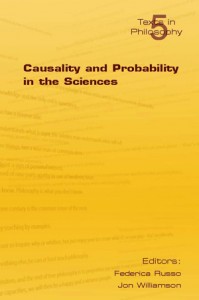Edited by Federica Russo and Jon Williamson
London: College Publications, Texts In Philosophy series, 2007
ISBN: 1-904987-35-4
Buy: UK, US
Introduction
Causal inference is perhaps the most important form of reasoning in the sciences. A panoply of disciplines, ranging from epidemiology to biology, from econometrics to physics, make use of probability and statistics to infer causal relationships. The social and health sciences analyse population-level data using statistical methods to infer average causal relations. In diagnosis of disease, probabilistic statements are based on population-level causal knowledge combined with knowledge of a particular person’s symptoms. For the physical sciences, the Salmon-Dowe account develops an analysis of causation based on the notion of process and interaction. In artificial intelligence, the development of graphical methods has leant impetus to a probabilistic analysis of causality. The biological sciences use probabilistic methods to look for evolutionary causes of the state of a current species and to look for genetic causal factors. This variegated situation raises at least two fundamental philosophical issues: about the relation between causality and probability, and about the interpretation of probability in causal analysis.
In this book we bring philosophers and scientists together to discuss the relation between causality and probability, and the applications of these concepts within the sciences.
Organisations
This volume is organised by Federica Russo and Jon Williamson as a part of the project: Causality and the interpretation of probability in the social and health sciences.
Acknowledgements
We are very grateful to the British Academy for providing financial support.
